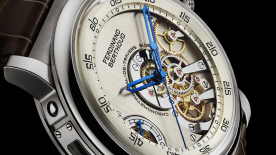OK, let’s begin by stating the obvious. Before you buy a watch, you have to try it on. What??! Seriously? You’ve got to be kidding! Getting an idea of what a watch feels like, how big it is and how comfortable, its different textures, its weight, whether it fits under your sleeve, how it looks on your wrist... But that’s ridiculous. Those ideas are obsolete, outdated, old-fashioned, pre-digital, practically prehistoric! These days, people prefer to buy online, remotely, from the comfort of their armchairs. It’s so much more convenient. It’s open 24/7. It’s tidy. It’s great. It’s the future!
So let’s get something else on the table: it’s not true. Where new watches are concerned, online sales are virtually non-existent. For the second-hand market, yes, it works because clients are shopping around for the best prices. And it makes sense to assume that they’ve already tried on the watch they’re buying, because they’ve all been available for some time. But for new watches?
There are virtually no reliable statistics, and precious little anecdotal information, about the proportion of new watch sales that take place online. What, none? Well, yes, there was one figure, which made a brief appearance before vanishing behind a deluge of other financial information. In its mid-year report for the first half of 2018, the Richemont group brought in a new category: Online Retail. Its purpose is to account for sales across all the group’s online storefronts, primarily Yoox Net-a-Porter, but also Watchfinder and all its brands’ online stores. Given that these kinds of documents require some basis for comparison, Richemont gives the figure for Q2 2018, after Yoox joined, as well as figures for the previous half-year period.
Between April and September 2017, Richemont’s 17 brands recorded online sales revenues of 64 million euros, which is 1% of total sales. That includes Montblanc and its leather goods, Chloé with its bags and tunics, jewellery from Cartier and Van Cleef, as well as watches. So, it’s fair to say that online watch sales represent considerably less than 1% of the group’s revenues. Which is not a lot.
And these websites are privileged channels. They’re built around user experience which, in case you haven’t heard, is the magical and meaningless concept that is supposed to eliminate the cold feet that plague internet shoppers when it comes to buying expensive items online. It brings the inanimate web to life. It fleshes out your smartphone screen. This dreamlike, enchanted, branded space that smells of strawberries and honey is the only way, we are told, of encouraging online sales. Well, sorry to break it to you, but it’s not working. It’s possible that new watches are selling better on other non-specialist websites, but if so, no one’s letting on. The most we ever hear is that some channels are “overperforming” or “exceeding expectations”. Which tells us precisely nothing. According to US retailer Tourneau, the leader in a market where online sales are well-established and a powerful driver, revenues from its online store (which serves a population of 325 million) are equivalent to those of one of its 24 brick-and-mortar stores.
You can buy a moderately-priced article online if you haven’t seen it. You can buy a higher-priced item if you are familiar with it, if you know how big it is, and if you know you can return it and get your money back, without burning a serious hole in your bank account. But let’s rewind a little: the annual report of Yoox Net-a-Porter, from before it was bought by Richemont, states that the average total at checkout, across all its sites, was around € 120. This is a long way from the luxury end of the watch market, which starts at € 1000. And it’s even further from the watch industry’s core territory, which is three to four times that. The implications, the perception of risk and the impulse to buy are all completely different.
But let’s get back to our original point. Watches need to be tried on. Few objects are quite so complex. There are very few items where the subtleties of detail, shape and sizing are so important. Few are so personal, worn all day long for many days at a time. Few are expected to last so long, unlike fashion items, clothing and accessories. Few represent such a commitment. A watch is a powerful vector of meaning, expressing style, taste, culture, affect, colour and materials.
So, drag yourself away from your screens and get yourself out to the shops. Instagram and watch sites (yes, even WorldTempus) are merely a starting point. You need to develop a real, non-virtual appreciation for the watch. Try it on. Go on, do yourself a favour. That’s what the shops are for. The assistants are there to help you. Use them. And if you leave empty-handed, so be it. Even in this era of globalised digital consumption, watches remain living objects, and they need to be seen in the flesh. Afterwards, feel free to buy it from whichever outlet you choose, wherever it’s available. At least you’ll know what you’re getting into.




